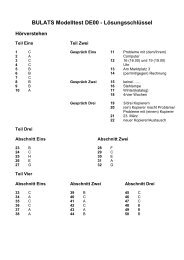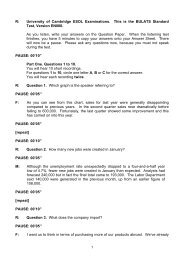BULATS tapescript EN000A
BULATS tapescript EN000A
BULATS tapescript EN000A
You also want an ePaper? Increase the reach of your titles
YUMPU automatically turns print PDFs into web optimized ePapers that Google loves.
R: University of Cambridge ESOL Examinations. This is the <strong>BULATS</strong> Standard<br />
Test, Version <strong>EN000A</strong>.<br />
As you listen, write your answers on the Question Paper. When the listening test<br />
finishes, you have 5 minutes to copy your answers onto your Answer Sheet. There<br />
will now be a pause. Please ask any questions now, because you must not speak<br />
during the test.<br />
PAUSE: 00’10”<br />
Part One. Questions 1 to 10.<br />
You will hear 10 short recordings.<br />
For questions 1 to 10, circle one letter A, B or C for the correct answer.<br />
You will hear each recording twice.<br />
R: Question 1. When must the woman be at the airport to meet Mr Kimoto?<br />
PAUSE: 00’05’’<br />
M: Jane, could you possibly meet Mr Kimoto off his flight today, please?<br />
F: It depends. What time’s he due to arrive? I’ve got the finance meeting at 2.30,<br />
remember?<br />
M: Well, he doesn’t land till 4.15 and the meeting’ll be over by half past three, won’t it?<br />
F: Quarter to four probably. But yes, I should just about make it…<br />
M: Thanks!<br />
PAUSE: 00’05”<br />
[repeat]<br />
PAUSE: 00’10”<br />
R: Question 2. How much will it cost the woman to rent a car?<br />
PAUSE: 00’05’’<br />
F: I’ve got to go to a lot of meetings while I’m here. How much would it be to rent a<br />
car?<br />
M: It’s ninety-five pounds per week for standard cars, or a hundred and twenty pounds<br />
for the luxury models.<br />
F: I only need it for three days. The standard model’s fine.<br />
1
M: That would be sixty pounds, at the daily rate of twenty pounds, including insurance.<br />
F: That’s OK. (fade). Um ......<br />
PAUSE: 00’05”<br />
[repeat]<br />
PAUSE: 00’10”<br />
R: Question 3. Which chart shows the company’s sales?<br />
PAUSE: 00’05’’<br />
M: Although turnover has been disappointing, things are beginning to look more<br />
positive. Sales have risen sharply since starting to recover in the second quarter.<br />
However, this rate of increase is unlikely to continue beyond the early part of next<br />
year ....... (fade)<br />
PAUSE: 00’05”<br />
[repeat]<br />
PAUSE: 00’10”<br />
R: Question 4. Which is Mr Fielding’s office?<br />
PAUSE: 00’05’’<br />
M: Can you tell me where Mr Fielding’s office is please?<br />
F: Yes… go through those double doors and then straight on. It’s the second room on<br />
the right after the stairs….. his name’s on the door.<br />
M: Thank you.<br />
PAUSE: 00’05”<br />
[repeat]<br />
PAUSE: 00’10”<br />
R: Question 5. What does the company no longer manufacture?<br />
PAUSE: 00’05’’<br />
M: Meekstons Foods has announced plans to close its juice-making factory. Although<br />
2
it said the bread and bakery products division will remain in operation, staff are<br />
concerned as this announcement comes only weeks after its tinned-food<br />
production-line closed down. This… (fade)<br />
PAUSE: 00’05”<br />
[repeat]<br />
PAUSE: 00’10”<br />
R: Question 6. How many days’ holiday has Bob got left?<br />
PAUSE: 00’05’’<br />
F: Have you taken all your holiday this year yet, Bob?<br />
M: Oh no – I’ve still got almost 2 weeks left. Let me check – yes, 10 days. I’ve booked<br />
5 days off next month, and I’ll take some more days off in November.<br />
F: Right. Lucky you! I’ve only got a couple of days left.<br />
PAUSE: 00’05”<br />
[repeat]<br />
PAUSE: 00’10”<br />
R: Question 7. In which month will they advertise for temporary workers?<br />
PAUSE: 00’05’’<br />
M: I think we’ll need quite a few temporary workers this year.<br />
F: Yes, we should advertise early. A lot of companies will be in the same position.<br />
M: Well, shall I do it now?<br />
F: Um I think February’s a little soon. What about advertising in early April for the<br />
people we need in July?<br />
M: OK. I’ll make a note to do that.<br />
PAUSE: 00’05”<br />
[repeat]<br />
PAUSE: 00’10”<br />
3
R: Question 8. What has changed about the packaging?<br />
PAUSE: 00’05’’<br />
M: What’s the new packaging like?<br />
F: It’s certainly an improvement. We’ve kept the bright blue and the lettering, but it’s<br />
more practical now, with plastic instead of cardboard – we haven’t increased the<br />
measurements.<br />
M: Now let’s see if it helps sales!<br />
PAUSE: 00’05”<br />
[repeat]<br />
PAUSE: 00’10”<br />
R: Question 9. Why hasn’t GBM fixed the machines yet?<br />
PAUSE: 00’05’’<br />
M: GBM Machines here. About your packing machines which broke down last week.<br />
We couldn’t repair them even if we had the parts in stock. I’m afraid you need new<br />
machines. The engineer was wrong to say he could do the job.<br />
PAUSE: 00’05”<br />
[repeat]<br />
PAUSE: 00’10”<br />
R: Question 10. What should Peter Williams do?<br />
PAUSE: 00’05’’<br />
(ansaphone message)<br />
Hello, message for Peter Williams from Redco Supplies. We’re using a new courier<br />
service, so could you let me know as soon as your latest order arrives, just to be<br />
sure? It’s 50 litres of paint, order number 2-5-2-4.<br />
PAUSE: 00’05”<br />
[repeat]<br />
PAUSE: 00’10”<br />
4
R: Part Two. Questions 11 to 22.<br />
You will hear three conversations. Fill in the missing information in the numbered<br />
spaces, using one or two words or a number.<br />
You will hear each conversation once only.<br />
R: Conversation One. Questions 11 to 14.<br />
Look at the form below. You will hear a man being interviewed by a member of staff at a job<br />
agency.<br />
You have 20 seconds to look at the form.<br />
PAUSE: 00’20”<br />
R: Now listen and complete the form.<br />
PAUSE: 00’02”<br />
F: Good morning.<br />
M: Good morning. My name’s Derek Reid. I’m looking for a new job.<br />
F: Right, I’ll need some details. First, your qualifications.<br />
M: I did a three-year course at Portway College and got a Diploma in Design.<br />
F: And you’re working now?<br />
M: Yes, I’m a technician – at Lama Studios in Portway.<br />
F: So do you want to change the type of work that you do?<br />
M: No, the work’s OK. I’m just not getting anywhere. I’ve had the same job for four years<br />
without promotion.<br />
F: So what position are you looking for? Assistant Supervisor?<br />
M: No, Supervisor. I think I’ve got enough experience for that now and I really want to<br />
move ahead.<br />
F: And your salary requirements?<br />
M: Well, I’m on fifteen and a half thousand now, but I’d like to be getting a little more than<br />
that. I thought that eighteen thousand would be nearer.<br />
F: Fine. Thank you, Mr Reid.<br />
M: Thank you.<br />
11121314<br />
PAUSE: 00’15”<br />
5
R: Conversation Two. Questions 15 to 18.<br />
Look at the notes below. You will hear a conversation between two people talking about<br />
workshops.<br />
You have 20 seconds to look at the notes.<br />
PAUSE: 00’20”<br />
R: Now listen and complete the notes.<br />
PAUSE: 00’02”<br />
M: Hi, Jane. Nigel Masters from Penfolds here. I was wondering if you could meet to<br />
discuss the series of time management workshops you’re producing for our staff.<br />
F: Fine. When’s best for you? I’m fairly free most of this week.<br />
M: Well, I’m tied up tomorrow and the following day. What about Friday?<br />
F: Mm. I’m visiting a client in the morning. Would 3pm be okay?<br />
M: Could you make it a little earlier. Say two?<br />
F: What about half past?<br />
M: Uhu.<br />
F: I’ve got the outline plans for each workshop. I just need to get some more information<br />
from you.<br />
M: What kind of info?<br />
F: You haven’t let me know if you expect technical staff to come to the workshop. I know<br />
you want the non-technical staff there.<br />
M: That’s true. I haven’t had time to look at that yet. Is it possible for all of them to go?<br />
F: Oh yes, of course. But I will need to have their job descriptions.<br />
M: No problem. I’ll have that ready for Friday.<br />
15161718<br />
PAUSE: 00’15”<br />
6
R: Conversation Three. Questions 19 to 22.<br />
Look at the notes below. You will hear a man giving his PA some instructions.<br />
You have 20 seconds to look at the notes.<br />
PAUSE: 00’20”<br />
Now listen and complete the notes.<br />
PAUSE: 00’02”<br />
M: Sara, can you do a few things for me while I’m out? They all need sorting today.<br />
F: Yes – I was going to contact you because the ad company said they wanted that<br />
cheque immediately.<br />
M: The book’s in my desk. Could you fill it in, sign it and get it in the post?<br />
F: OK.<br />
M: Then if you go into the October file on the computer you’ll see the turnover<br />
figures. Can you put them into the standard format and send them to everybody<br />
in the department?<br />
F: Right. And shall I chase up Presto Stationery Limited about those leaflets?<br />
They’re still not here and the launch is next week.<br />
M: Yup – and, last thing, the marketing manager asked to see the new sales contract<br />
– the one we give the shops. Can you get a copy to him? Thanks … (fade) ...<br />
19202122<br />
PAUSE: 00’15”<br />
7
R: Part Three. Section One. Questions 23 to 27.<br />
You will hear five speakers talking about the findings of surveys into shopping patterns.<br />
As you listen, decide which survey-finding each speaker refers to.<br />
Choose your answer from the list A to I, and write the correct letter in the space provided.<br />
You will hear the five pieces once only.<br />
You have 20 seconds to read the list A to I.<br />
PAUSE: 00’20’’<br />
R: Now listen to the example.<br />
PAUSE: 00’02”<br />
F: As a proportion of expenditure, total spend on spare time activities at home and<br />
outside the home, holidays and entertainment has more than doubled since 1978.<br />
It has increased from 9% in '78 to 20% now, much faster than the growth in spend<br />
on groceries. The largest growth in this area is in holiday expenditure, where<br />
outlay shot up from £16 a week to £54 per week.<br />
PAUSE: 00’02”<br />
R: They are talking about how expenditure on leisure services has increased<br />
dramatically, so you write ‘I’ as your answer.<br />
PAUSE: 00’05”<br />
R: Question 23. Person 1.<br />
M: Consumers are now spending only £7 more on their shopping for groceries than on<br />
food bought in restaurants, hotels and other such places. It is the younger<br />
generation who are leading this trend, with under-30s spending 11% on food<br />
prepared and consumed outside the home, while the over 75’s spend just 6%.<br />
PAUSE: 00’10”<br />
R: Question 24. Person 2.<br />
F: Consumers may complain about the size of the weekly grocery bill, but the outlay<br />
on food and drink is not as much as in other household areas such as transport and<br />
recreation. Only in the group of consumers who have the lowest income does food<br />
and drink top the list of household costs.<br />
PAUSE: 00’10”<br />
8
R: Question 25. Person 3.<br />
M: When it comes to better eating habits, it’s 59 to 64-year-olds who are setting the<br />
positive example to other consumers. They spend more on fresh fruit and<br />
vegetables than any other age group. The under 30’s age group spend the least on<br />
fresh produce, despite the efforts of doctors and educationalists to get them to eat<br />
food which is good for them.<br />
PAUSE: 00’10”<br />
R: Question 26. Person 4.<br />
F: Households spend nowhere near the same amount on food and drink as they did in<br />
the 1970s. The outlay on food and drink is a much smaller part of the household’s<br />
weekly income, down from 24% in 1978 to only 17% now – the biggest decline in<br />
any area of household expenditure. The amount spent on clothing and footwear<br />
also fell from 8% to 6% over the same period.<br />
PAUSE: 00’10”<br />
R: Question 27. Person 5.<br />
M: People living in cities lead expensive lives, but of all the different groups of housing<br />
locations, consumers living in the country spend the most on food and drink.<br />
Households with the next biggest grocery bills are those which have one adult living<br />
with children. For them, expenditure on leisure and holidays is the smallest part of<br />
weekly income.<br />
PAUSE: 00’15”<br />
9
R: Part Three. Section Two. Questions 28 to 32.<br />
You will hear five business owners talking about developing a new product and bringing it to<br />
market.<br />
As you listen, decide what advice each business owner gives about developing a new<br />
product and bringing it to market.<br />
Choose your answer from the list A to I, and write the correct letter in the space provided.<br />
You will hear the five pieces once only.<br />
You have 20 seconds to read the list A to I.<br />
PAUSE: 00’20’’<br />
R: Now listen to the example.<br />
PAUSE: 00’02”<br />
M: Are you clear about what you hope to achieve with the new product? The clearer<br />
you are about your plans, the better you can analyse the risks involved. Does the<br />
new product improve your range? Decide whether it fits customers’ requirements.<br />
For example, you should consider its design, ease of use and performance<br />
benefits.<br />
PAUSE: 00’02”<br />
R: He is talking about checking that the product meets the exact needs of customers, so<br />
you write ‘I’ as your answer.<br />
PAUSE: 00’05”<br />
R: Question 28. Person 1.<br />
F: How technologically feasible is the product? Can you meet its design, resources<br />
and production requirements? It makes sense to consult members of your staff<br />
about these aspects of your development plans – they may contribute insights that<br />
you have overlooked. It’s good to get a range of opinions on exactly how easy it’s<br />
going to be to achieve what you want.<br />
PAUSE: 00’10”<br />
R: Question 29. Person 2.<br />
M: Test lots of ideas at the start of a project – it costs relatively little to assess which<br />
are most promising. Write down detailed specifications so that you’ve got<br />
everything in black and white. Most importantly, consider the regulatory framework<br />
that your new product will operate in, so you don’t develop it, then have to<br />
abandon it because of the law. Do some research.<br />
PAUSE: 00’10”<br />
10
R: Question 30. Person 3.<br />
F: When you’ve decided on the product you’ll develop, you must create a project<br />
team, and it’s vitally important you get this right. In putting together your team you<br />
need to include employees with a variety of skills. For example, as well as a<br />
creative ideas person you may need a technical expert, and a sales specialist. All<br />
team members should understand your business objectives and be committed to<br />
them.<br />
PAUSE: 00’10”<br />
R: Question 31. Person 4.<br />
M: When it comes to marketing the new product, you must get your message across<br />
quickly. If you get the chance to speak to a buyer, you need to catch their attention<br />
immediately – they’re extremely busy people. It’s definitely down to preparation, so<br />
I’d recommend rehearsing your sales pitch in front of anyone who’ll listen – not<br />
delivering it for the first time to the top buyer of a potentially major client.<br />
PAUSE: 00’10”<br />
R: Question 32. Person 5.<br />
M: Don’t take no for an answer. It took three years to get our new products to market.<br />
A lot of this time was spent on design and safety testing, but it took 18 months of<br />
talking to one well-known retailer before they agreed to stock our new product.<br />
Once you’re in there with one retail chain, it gets much easier to approach others.<br />
But you have to be persistent in order to succeed.<br />
PAUSE: 00’15”<br />
11
R: Part Four. Section One. Questions 33 to 38.<br />
333435363738<br />
You will hear a conversation between a university student, Sally, and a company<br />
representative, Dan, at a recruitment seminar. Sally is interested in working for Dan's<br />
company, Manson's plc.<br />
For questions 33 – 38, circle one letter A, B or C for the correct answer.<br />
You will hear the conversation twice.<br />
You have 20 seconds to read the questions.<br />
PAUSE:<br />
00'20"<br />
R: You will now hear the conversation.<br />
PAUSE:<br />
00'02"<br />
F2: Hello, I'm Sally Robinson, a student.<br />
M2: Hello Sally, Dan Stone.<br />
F2: I'm very interested in working for your company.<br />
M2: When do you finish studying?<br />
F2: Oh, not long now, after this month's holiday, I've got two weeks of exams, and then it's<br />
over. Just six weeks left as a student!<br />
M2: Right, so you'd like to join Manson's this year?<br />
F2: Yes.<br />
M2: Which department?<br />
F2: Well, I've done a lot of degree assignments on marketing – I found it a lot more<br />
interesting than financial management – and during my holidays I've done some<br />
research for local food retailers. That's the sort of thing I'd like to do.<br />
M2: Yes, well, they usually have vacancies. But it can depend on where you want to work.<br />
F2: I don't mind where I go.<br />
M2: As well as our European divisions, we're just setting up printing operations in Hong<br />
Kong. So the opportunities are good. We get thousands of applicants every year.<br />
F2: I know. What sort of people do Manson's like?<br />
M2: Well we get a lot of candidates with good academic qualifications, but that's not<br />
necessarily what a dynamic company like Manson's needs. It's better to have<br />
employees who really want to find out everything about the job – then they can<br />
develop.<br />
12
F2: Uh-huh, so can you tell me about the training.<br />
M2: Yes – you'd be sent on several courses – market development, that's the first course<br />
you'll do, within a few weeks of starting, and then sales techniques and personnel<br />
management – those'll be later, after you've completed your first year.<br />
F2: I see. And there's a progress assessment every six months, am I right?<br />
M2: No. For the first 12 months they assess your progress every quarter.<br />
F2: You mean every three months?<br />
M2: Yup. Look, I've got an application form here – I could help you fill it in if you like.<br />
F2: Oh, no, it's OK, I've already done one. Shall I give it to you?<br />
M2: Um .. Well, it would probably be quicker if you sent it actually – I'm not going back to<br />
Head Office for 4 or 5 days, so ..<br />
F2: OK. Would you mind having a quick look at my form, just to see if you think I could<br />
improve it?<br />
M2: All right. (rustling papers) .. hmmm ... not bad ... you've written about your positions of<br />
responsibility and what you're interested in .. [fade]<br />
PAUSE:<br />
00'02"<br />
R: Now you will hear the conversation again.<br />
[repeat]<br />
PAUSE:<br />
00'10"<br />
13
R: Part Four. Section Two. Questions 39 to 44.<br />
You will hear Ed Mason, a business consultant, giving a talk about succession<br />
planning, which is planning to appoint a successor for the retiring leader of a company.<br />
For questions 39 to 44, circle one letter, A, B or C for the correct answer.<br />
You will hear the talk twice.<br />
You have 20 seconds to read the questions.<br />
PAUSE: 00’20”<br />
R: Now you will hear the talk.<br />
PAUSE: 00’02”<br />
M:<br />
(US)<br />
My name’s Ed Mason, I’m a business consultant, and I specialise in succession<br />
planning. Now, why is succession planning a problem for you as business owners?<br />
Some 75 percent of private firms in this country are family owned. However, fewer<br />
than half of first-generation family businesses have succession plans. Common<br />
reasons include resistance by the owner to let go of the responsibility, fear of<br />
retirement or inability to find an effective successor. Of course, transferring ownership<br />
can be emotional and complicated, which is why it’s often ignored until it becomes an<br />
urgent issue, for example, when the owner falls ill.<br />
So it’s necessary to have a succession plan. You don’t need to bring in lawyers in the<br />
early stages, but with a formal plan you can know what course of action you intend to<br />
take, when and how. Also, setting it down in black and white may show you it has<br />
shortcomings, and that more effective strategies need to be employed. Decide how<br />
you will hand over control of your business, then work out a timetable of necessary<br />
steps. This needs to be meticulously planned and executed, and it can take several<br />
years.<br />
It’s important to get succession planning right because this affects the company in<br />
many ways. Leaving succession planning until it’s too late can have several<br />
consequences. A panic decision could mean the business is transferred to someone<br />
who is not able to do the job. The business could be severely disrupted if there are<br />
arguments about who should take over the business, while uncertainty and lack of<br />
leadership could have a disastrous effect on sales and morale within the company.<br />
Getting support for your ideas is a key requirement. Your succession plan needs to be<br />
communicated effectively to other people within your business. This means letting<br />
senior staff, customers and suppliers know of your intention to step down – and timing<br />
is crucial. The last thing you need is people to lose faith in the company when they<br />
hear you’ll no longer be involved. Throughout, it’s important to seek expert advice on<br />
every aspect of handing over ownership of your business – not least of which is<br />
taxation. There’ll be implications for both your personal finances and those of the<br />
business.<br />
One of the most difficult challenges that owners face in advance of retiring is learning<br />
to go less often into the office, to work shorter days. In my experience, they find this<br />
harder than deciding how they will actually dispose of the company. You might choose<br />
to transfer ownership of the company to a family member, or you might dispose of it<br />
14
through a management buy-out. Whichever you do, you have to take less and less<br />
part in running of the company. Though bear in mind that you’ll have total involvement<br />
if you decide to sell the business, or wind it up altogether.<br />
Here is some advice on choosing a successor. Begin by considering whether there’s<br />
an obvious choice of successor within the business. This could be someone who’s<br />
worked for you for some time, someone who knows the business well and who has<br />
the necessary skills to take control. You need to be absolutely certain your chosen<br />
candidate is capable of taking your business forward. Alternatively, though this bears<br />
more risk, you might opt for an external appointment. It is much more risky to make an<br />
external appointment, even if it’s someone who has good ideas.<br />
394041424344<br />
PAUSE: 00’02”<br />
R: Now you will hear the talk again.<br />
PAUSE: 00’02”<br />
[repeat]<br />
PAUSE: 00’10”<br />
15
R: Part Four. Section Three. Questions 45 to 50.<br />
You will hear an interview with Ian Cole, a business consultant, about customer<br />
surveys.<br />
For questions 45 to 50, circle one letter, A, B or C for the correct answer.<br />
You will hear the interview twice.<br />
You have 20 seconds to read the questions.<br />
PAUSE: 00’20”<br />
R: Now you will hear the interview.<br />
PAUSE: 00’02”<br />
F: In the studio today I have marketing consultant Ian Cole, who’s an expert on<br />
measuring customer satisfaction. What’s your opinion of the value of this activity, Ian?<br />
M: The term ‘customer satisfaction’ has long been in use, and analysts claim it’s a major<br />
determinant of success in business. Companies spend time and money on research,<br />
trying to measure how pleased their customers are. Theoretically, this is vitally<br />
important information. In my experience, however, the outcomes of a survey don’t<br />
reveal the true picture.<br />
F: So is it that companies don’t necessarily benefit from their research?<br />
M: I believe so. Companies incorrectly think that ‘satisfaction’ means ‘loyalty’. It’s often<br />
the case that customers are satisfied, but if they believe they’d be equally, or better<br />
satisfied with any other provider, they’ll switch. To get an accurate measurement of<br />
loyalty, a new type of questionnaire with a different scale is required. In this new scale,<br />
the middle answer is: ‘Fine. I have no complaints: but I didn’t feel the product or<br />
service was anything special.’ This is likely what most of your customers actually think<br />
about you.<br />
F: OK, so how easy is it to get an accurate or precise picture of customers?<br />
M: Not that easy. Be careful of how you read results in tough times. Recent studies of the<br />
fast-food industry show that when there’s a recession, consumers are willing to reduce<br />
their own ‘total satisfaction’ in favour of buying at ‘purely the lowest price’. Though, if<br />
you want to differentiate your customers in a more positive way, a rating could be<br />
‘Better than I could expect from another provider.’ Here, long-term loyalty begins to<br />
assert itself.<br />
F: And what about the customers themselves? What should they take account of?<br />
M: Sometimes they’re lazy. For example, a customer goes to have their car repaired, and<br />
as they leave the dealership, the salesman gives them a feedback sheet. He says that<br />
company’s goal is to have a perfect score, and asks if there’s anything he can do to<br />
make that happen. While the guideline is disguised as an offer of service, in fact all he<br />
really cares about is getting a good score. The customer isn’t doing the company any<br />
favours because it never learns the truth – that the customer really didn’t think they<br />
were anything special.<br />
16
F: And senior executives, what about them? They should be aware of these meaningless<br />
surveys.<br />
M: Some executives don’t bother to check the reality behind the reports on customer<br />
surveys. Employees of some companies can actually block certain customers – ones<br />
they believe would give them negative feedback – from getting survey calls. In<br />
addition, some companies make it difficult to give unsolicited feedback. After a recent<br />
terrible car-repair experience, I tried to contact the dealership’s customer service<br />
department. It was nearly impossible.<br />
F: And the internet plays a part in these matters.<br />
M: Indeed. Being on top of your feedback is more important than ever because of the<br />
transparency created by the internet. If customers can’t tell you where you’re going<br />
wrong, they’ll tell someone else. Internet forums allow them to share their feedback,<br />
positive or negative, with anyone who might go looking for it. Every product failing is<br />
detailed on consumer websites. Also, consumers with technical skills are likely to seek<br />
input from such forums before any major purchasing decision.<br />
454647484950<br />
PAUSE: 00’02”<br />
R: Now you will hear the interview again.<br />
PAUSE: 00’02”<br />
[repeat]<br />
PAUSE: 00’10”<br />
R: That is the end of the Listening Section. You now have 5 minutes to copy your<br />
answers onto your Answer Sheet.<br />
17
















